
Kayseri is a large city in Central Anatolia, Turkey, and the capital of Kayseri province. Historically known as Caesarea, it has been the historical capital of Cappadocia since ancient times. The Kayseri Metropolitan Municipality area is composed of five districts: the two central districts of Kocasinan and Melikgazi, and since 2004, also outlying Hacılar, İncesu and Talas.

The Kayseri Province is a province and metropolitan municipality in central Turkey. Its area is 16,970 km2, and its population is 1,441,523 (2022). It borders with Sivas, Adana, Niğde, Kahramanmaraş, Yozgat and Nevşehir provinces.

İnce Minareli Medrese is a 13th-century madrasa located in Konya, Turkey, now housing the Museum of Stone and Wood Art, noted for its ornate entrance, domed courtyard, ornamentally bricked minaret, partially destroyed in 1901, and exemplar Anatolian Seljuk architecture.

The Selimiye Mosque is an Ottoman imperial mosque, located in the city of Edirne, Turkey. It was commissioned by Sultan Selim II and was built by the imperial architect Mimar Sinan between 1568 and 1575. It was considered by Sinan to be his masterpiece and is one of the highest achievements of Islamic architecture as a whole and Ottoman architecture in particular.

The Bayezid II Mosque is an early 16th-century Ottoman imperial mosque located in Beyazıt Square in Istanbul, Turkey, near the ruins of the Forum of Theodosius of ancient Constantinople.

The large Fatih Mosque is an Ottoman mosque off Fevzi Paşa Caddesi in the Fatih district of Istanbul, Turkey. The original mosque was constructed between 1463 and 1470 on the site of the Church of the Holy Apostles. Seriously damaged in the 1766 earthquake, it was rebuilt in 1771 to a different design. It is named after the Ottoman sultan Mehmed the Conqueror, known in Turkish as Fatih Sultan Mehmed, who conquered Constantinople in 1453.

The Yivli Minaret Mosque, also known as the Alaaddin Mosque or simply Grand Mosque, in Antalya is a historical mosque built by the Anatolian Seljuk Sultan Kay Qubadh I. It is part of a külliye which includes the Gıyaseddin Keyhü
Gevher Nesibe was an early 13th century princess of the Sultanate of Rum, the daughter of Kilij Arslan II and sister of Kaykhusraw I.
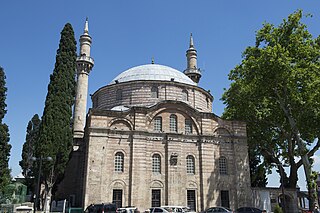
The Emir Sultan Mosque is in Bursa, Turkey. First built in the 15th century, it was rebuilt in 1804 for the Ottoman sultan Selim III, and rebuilt again in 1868, the plan of the mosque changing slightly with each rebuild.

Muʿīn al-Dīn Sulaymān Parwāna, simply known as Parwāna, was a Persian statesman, who was for a time a key player in Anatolian politics involving the Seljuk Sultanate of Rûm, the Mongol Ilkhanate and the Mamluks under Baybars.
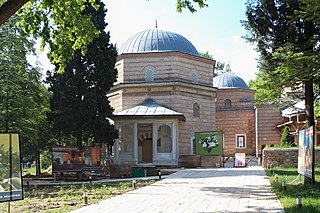
The Muradiye Complex or the Complex of Sultan Murad II, the Ottoman sultan, is located in Bursa, Turkey.

The Pertevniyal Valide Sultan Mosque, also known as the Aksaray Valide Mosque, is a grand Ottoman imperial mosque in Istanbul, Turkey. It is located at the intersection of Ordu Street and Atatürk Boulevard in the Aksaray neighborhood beside the Pertevniyal High School which was also built by the order of Sultana Pertevniyal in 1872. The mosque attracts 400-500 worshipers during prayer times and over 2,500 worshipers during prayer on Fridays.
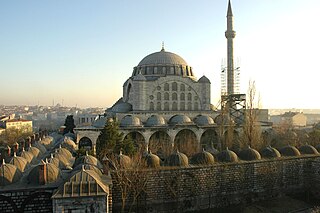
The Mihrimah Sultan Mosque is a 16th-century Ottoman mosque located near the Byzantine land walls in the Edirnekapı neighborhood of Istanbul, Turkey. It was commissioned by Mihrimah Sultan, the daughter of Suleiman the Magnificent, and designed by the chief imperial architect Mimar Sinan. Sited on the summit of the Sixth Hill near the highest point of the city, the mosque is a prominent city landmark.

Seljuk architecture comprises the building traditions that developed under the Seljuk dynasty, when it ruled most of the Middle East and Anatolia during the 11th to 13th centuries. The Great Seljuk Empire contributed significantly to the architecture of Iran and surrounding regions, introducing innovations such as the symmetrical four-iwan layout and the first widespread creation of state-sponsored madrasas. Their buildings were generally constructed in brick, with decoration created using brickwork, tiles, and carved stucco.
The Sahn-ı Seman Medrese or Semâniyye was a 15th-century Ottoman medrese (madrasa) complex in Istanbul, Turkey, which was part of the Fatih Mosque. It was one of the highest educational facilities for various sciences such as theology, law, medicine, astronomy, physics and mathematics, and was founded by the astronomer Ali Qushji who was invited by the Ottoman sultan Fatih Sultan Mehmed to his court in Istanbul.

Hatuniye is a historical külliye, an Islamic religious complex, located in the city center of Tokat, Turkey. Its 1485 construction was ordered by Ottoman Sultan Bayezid II in honour of his mother, Gülbahar Hatun. Its facilities include a mosque, an imaret, and a medrese. At present the mosque is used for prayer and other religious services, while the rest of the complex is open to visits by tourists and the public in general.
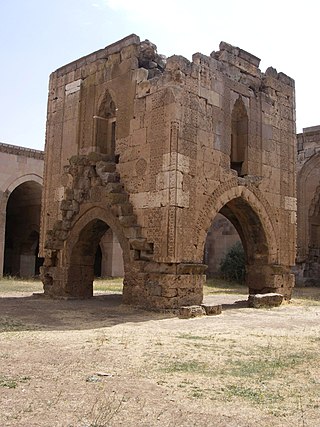
Sultan Han is a historic Seljuk-era caravanserai in Turkey, located 47 km northeast of Kayseri on the road to Sivas, in an area also known as Tuzhisar. It was built between 1232 and 1237 CE by Sultan Ala ad-Din Kayqubad I.
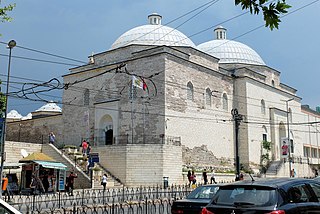
The Bayezid II Hamam is a historic bathhouse (hamam) on Divanyolu Street in Istanbul, Turkey. It was historically part of the külliye of the nearby Bayezid II Mosque and was one of largest hamams in the city.

Classical Ottoman architecture is a period in Ottoman architecture generally including the 16th and 17th centuries. The period is most strongly associated with the works of Mimar Sinan, who was Chief Court Architect under three sultans between 1538 and 1588. The start of the period also coincided with the long reign of Suleiman the Magnificent, which is recognized as the apogee of Ottoman political and cultural development, with extensive patronage in art and architecture by the sultan, his family, and his high-ranking officials.

Early Ottoman architecture corresponds to the period of Ottoman architecture roughly up to the 15th century. This article covers the history of Ottoman architecture up to the end of Bayezid II's reign, prior to the advent of what is generally considered "classical" Ottoman architecture in the 16th century. Early Ottoman architecture was a continuation of earlier Seljuk and Beylik architecture while also incorporating local Byzantine influences. The new styles took shape in the capital cities of Bursa and Edirne as well as in other important early Ottoman cities such as Iznik. Three main types of structures predominated in this early period: single-domed mosques, "T-plan" buildings, and multi-domed buildings. Religious buildings were often part of larger charitable complexes (külliyes) that included other structures such as madrasas, hammams, tombs, and commercial establishments.
























